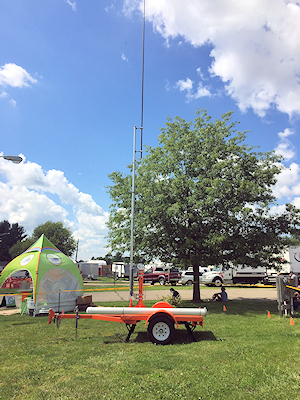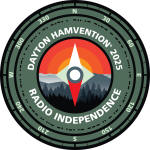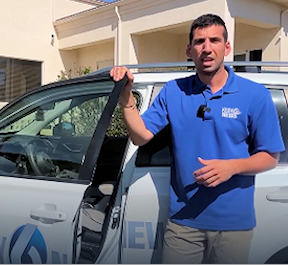| Radio Comes Home | | EventCAST Radio to Broadcast at Premier HAM Radio Event |  | | Information Radio Station 1620 Portable Antenna System | XENIA, OH: So why wouldn’t the world’s premier Amateur Radio Event use radio to reach out to attendees? Actually, they do. For the 6th year, the Dayton Hamvention will broadcast to more than 30,000 inbound patrons on AM frequency 1620 as they stream into the Expo Center and Fairgrounds in nearby Xenia for their mega-radio-convention.
It was Amateur Radio Operators whose innovations launched the entire telecommunications industry more than 100 years ago, and they continue the tradition today. Hamvention General Chairman Brian Markland reminds patrons, “Our 2025 theme, ‘Radio Independence,’  celebrates the freedom and resilience that have always defined amateur radio. Today, we’re fortunate to enjoy the freedom to explore, connect and create without limits.” celebrates the freedom and resilience that have always defined amateur radio. Today, we’re fortunate to enjoy the freedom to explore, connect and create without limits.”
That creativity extends to the event’s Information Radio service, as well. The “Hamvention Information Station” program will include standard parking and directions plus interviews with the mayor of Xenia, event organizers and patrons as they walk among the exhibits. A new tech segment will feature answers to “Way too Easy HAM Radio Questions.” The 3-5 mile EventCAST signal is designed to blanket the City of Xenia and nearby areas of Greene County in Ohio. |  | | EventCAST Radio equipment at Hamvention 2024 | Portable Information Radio services have been utilized by a variety of operators in recent years -- from Grand Canyon National Park, the Indianapolis 500, Oceano Dunes Off-Road Area, Pine Knob Music Theater, Illinois’ Farm Progress Show, multiple air shows and state fairs. More about EventCAST.
“As we count down the days to Hamvention, we invite you to reflect on what radio Independence means to you,” Markland says. “However you experience it, we can’t wait to celebrate it with you.” |
| | OPINION FROM THE SOURCE |  | | Dylan Foreman of KSBY Television | | Will AI perform at crunch time? | | Can the public trust AI-driven notification systems the next time disaster approaches? | LOS ANGELES, CA: Will the public trust AI-generated emergency notifications when it counts? The answer may depend on just where they live. In the Los Angeles area, which recently experienced the tragic fires, and in the Eastern US, which suffered through hurricanes Helene and Milton (Fall The Source), the jury may still be out.
On the ground in LA, Kort Waddell told The Source in January, “People are being told one thing, then another. Emergency cellphone alerts are going rogue." Not a confidence-builder, to be sure. Residents must trust public authorities with their lives when crises arrive at their doorsteps.
Into this arena rides a breed of new notification systems marshalled by Artificial Intelligence (AI). Questions abound: Will we trust AI systems to direct us to safety? What happens if the Internet is offline? What about protection of sensitive data? Will an evacuation system powered by AI fairly address all populations at risk, or will it have to prioritize? Artificial Intelligence offers the real potential to streamline notification processes, but will it do so with the experience and wisdom of a human emergency manager? And if it gets it wrong, who is to blame?
But alas, the horse is already out of the barn. The next time you are notified of an emergency, odds are AI will already have had a role in crafting the communication. A quick scan of FEMA’s website Federal Emergency Management Agency – AI Use Cases | Homeland Security details how the Agency rourtinely uses AI now "in its day-to-day activities to help people before, during, and after disasters.”
Meanwhile, the public jury is not just “out.” It may have already been dismissed. National surveys indicate a deep distrust in the reliability of Artificial Intelligence. (Google “Distrust of Artificial Intelligence” to see the growing list of research studies by researchers at universities such as MIT, Harvard and others.) Fueling the unease: a recent New York Times article stating that the newest AI “reasoning” systems are producing more – not less – incorrect information, referred to as “hallucinations.” The article asserts that even the companies that create the AI tools don’t understand why that’s happening.
But the public demands accuracy and clarity – not uncertainty – when an emergency is at hand. That likely explains the explosion of interest in Emergency Information Radio Systems by communities around Los Angeles, some of which personally experienced the recent chaos. Nearby Santa Barbara County (KSBY story) recently installed six Emergency Information Radio systems in preparation for the eventuality. Many other counties and cities are adding or upgrading stations. Radio was the first tool of telecommunications and now it’s the last one standing that affords local officials the ability to talk directly to citizens, without relying on third party points-of-failure like cell towers, the internet or an "AI Assistant." Like the old-school “can-and string” example, local radio allows emergency managers control of both cans … and the string too.
See "Communities Aim to Be 'Radio Ready' before the Next Round," The Source. |
|

